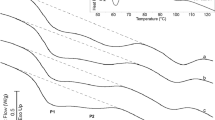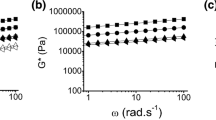Abstract
Fiber-enriched breads can contribute to increasing the daily fiber intake. Resistant starches (RS) are a useful resource to increase the amount of non-digestible carbohydrates while preserving as far as possible the technological quality of white bread. The effects of high concentrations of Hi-Maize (HM), a type 2 RS, in dough formulations were analyzed by farinograph, dynamic rheometric assays, texture profile analysis, and 1H-NMR relaxation measurements and related to particle size and microstructural characteristics studied by different microscopy techniques (SEM, ESEM, CLSM). Up to 30% replacement with HM was performed. Water absorption increased and development time and stability decreased when the amount of HM increased. Water mobility increased suggesting a change in water binding. The mechanical spectra indicated a prevalence of the solid-like character in all samples, but the G′ (storage modulus) vs. G″ (loss modulus) plot suggested a pronounced change in the microstructure of dough at the highest level of replacement. Dough was harder, more adhesive, and less resilient when the HM content was increased. The use of HM in the premix formulations not only diluted the gluten content but also changed the size particle distribution of starch granules by increasing the fraction with smaller sizes. Thus, more compact matrices were obtained with a noticeable disruption of the gluten network at the highest level of replacement. However, an intermediate level of RS addition (20%) still rendered a dough with satisfactory rheological properties for breadmaking.





Similar content being viewed by others
References
AACC International. (2000a). Farinograph method for flour 54-21.01. In: AACC International approved methods (pp. 1–7). AACC International.
AACC International. (2000b). Solvent retention capacity profile 56-11.02. In: AACC International approved methods (pp. 1–2). AACC International.
Ahmed, J., Almusallam, A. S., Al-Salman, F., AbdulRahman, M. H., & Al-Salem, E. (2013). Rheological properties of water insoluble date fiber incorporated wheat flour dough. LWT-Food Science and Technology, 51(2), 409–416.
Aigster, A., Duncan, S. E., Conforti, F. D., & Barbeau, W. E. (2011). Physicochemical properties and sensory attributes of resistant starch-supplemented granola bars and cereals. LWT-Food Science and Technology, 44(10), 2159–2165.
Alfa, M. J., Strang, D., Tappia, P. S., Graham, M., Van Domselaar, G., Forbes, J. D., et al. (2017). A randomized trial to determine the impact of a digestion resistant starch composition on the gut microbiome in older and mid-age adults. Clinical Nutrition.
Almeida, E. L., Chang, Y. K., & Steel, C. J. (2013a). Dietary fibre sources in frozen part-baked bread: Influence on technological quality. LWT-Food Science and Technology, 53(1), 262–270.
Almeida, E. L., Chang, Y. K., & Steel, C. J. (2013b). Dietary fibre sources in bread: Influence on technological quality. LWT-Food Science and Technology, 50(2), 545–553.
Altuna, L., Ribotta, P. D., & Tadini, C. C. (2015). Effect of a combination of enzymes on dough rheology and physical and sensory properties of bread enriched with resistant starch. LWT-Food Science and Technology, 64(2), 867–873.
Altuna, L., Ribotta, P. D., & Tadini, C. C. (2016). Effect of a combination of enzymes on the fundamental rheological behavior of bread dough enriched with resistant starch. LWT-Food Science and Technology, 73, 267–273.
Aravind, N., Sissons, M., Fellows, C. M., Blazek, J., & Gilbert, E. P. (2013). Optimisation of resistant starch II and III levels in durum wheat pasta to reduce in vitro digestibility while maintaining processing and sensory characteristics. Food Chemistry, 136(2), 1100–1109.
Arp, C. G., Correa, M. J., Zuleta, Á., & Ferrero, C. (2017). Techno-functional properties of wheat flour-resistant starch mixtures applied to breadmaking. International Journal of Food Science and Technology, 52(2), 550–558.
Asp, N. G. (1992). Resistant starch. Proceedings from the second plenary meeting of EURESTA: European FLAIR concerted action on physiological implications of the consumption of resistant starch in man. Preface. European Journal of Clinical Nutrition, 46, S1.
Baixauli, R., Sanz, T., Salvador, A., & Fiszman, S. M. (2008). Muffins with resistant starch: Baking performance in relation to the rheological properties of the batter. Journal of Cereal Science, 47(3), 502–509.
Bigne, F., Puppo, M. C., & Ferrero, C. (2016). Rheological and microstructure characterization of composite dough with wheat and mesquite (Prosopis spp) flours. International Journal of Food Properties, 19(2), 243–256.
Brennan, M. A., Monro, J. A., & Brennan, C. S. (2008). Effect of inclusion of soluble and insoluble fibres into extruded breakfast cereal products made with reverse screw configuration. International Journal of Food Science and Technology, 43(12), 2278–2288.
Bustos, M. C., Perez, G. T., & León, A. E. (2011). Sensory and nutritional attributes of fibre-enriched pasta. LWT-Food Science and Technology, 44(6), 1429–1434. https://doi.org/10.1016/j.lwt.2011.02.002.
Correa, M. J., Añón, M. C., Pérez, G. T., & Ferrero, C. (2010). Effect of modified celluloses on dough rheology and microstructure. Food Research International, 43(3), 780–787.
Correa, M. J., Ferrer, E., Añón, M. C., & Ferrero, C. (2014). Interaction of modified celluloses and pectins with gluten proteins. Food Hydrocolloids, 35(0), 91–99.
Dhingra, S., & Jood, S. (2004). Effect of flour blending on functional, baking and organoleptic characteristics of bread. International Journal of Food Science and Technology, 39(2), 213–222.
Doona, C. J., & Baik, M.-Y. (2007). Molecular mobility in model dough systems studied by time-domain nuclear magnetic resonance spectroscopy. Journal of Cereal Science, 45(3), 257–262.
Fuentes-Zaragoza, E., Riquelme-Navarrete, M. J. J., Sánchez-Zapata, E., & Pérez-Álvarez, J. A. (2010). Resistant starch as functional ingredient: a review. Food Research International, 43(4), 931–942.
Genovese, D. B. (2012). Shear rheology of hard-sphere, dispersed, and aggregated suspensions, and filler-matrix composites. Advances in Colloid and Interface Science, 171–172, 1–16.
Grabitske, H. A., & Slavin, J. L. (2009). Gastrointestinal effects of low-digestible carbohydrates. Critical Reviews in Food Science and Nutrition, 49(4), 327–360.
Hasjim, J., Ai, Y., & Jane, J. (2013). Novel applications of amylose-lipid complex as resistant starch type 5. In Y. C. Shi & C. C. Maningat (Eds.), Resistant starch sources, applications and health benefits (pp. 79–94). Chichester: John Wiley and Sons Ltd..
Keenan, M. J., Zhou, J., McCutcheon, K. L., Raggio, A. M., Bateman, H. G., Todd, E., Jones, C. K., Tulley, R. T., Melton, S., Martin, R. J., & Hegsted, M. (2006). Effects of resistant starch, a non-digestible fermentable fiber, on reducing body fat. Obesity (Silver Spring, Md.), 14(9), 1523–1534.
Korus, J., Witczak, M., Ziobro, R., & Juszczak, L. (2009). The impact of resistant starch on characteristics of gluten-free dough and bread. Food Hydrocolloids, 23(3), 988–995.
Kweon, M., Slade, L., & Levine, H. (2011). Solvent retention capacity (SRC) testing of wheat flour: Principles and value in predicting flour functionality in different wheat-based food processes and in wheat breeding—a review. Cereal Chemistry Journal, 88(6), 537–552.
Nugent, A. P. (2005). Health properties of resistant starch. Nutrition Bulletin, 30(1), 27–54.
Rueda, M. M., Auscher, M.-C., Fulchiron, R., Périé, T., Martin, G., Sonntag, P., & Cassagnau, P. (2016). Rheology and applications of highly filled polymers: a review of current understanding. Progress in Polymer Science, 66, 22–53.
Sabanis, D., & Tzia, C. (2009). Effect of rice, corn and soy flour addition on characteristics of bread produced from different wheat cultivars. Food and Bioprocess Technology, 2(1), 68–79.
Salinas, M., Carbas, B., Brites, C., & Puppo, M. (2015). Influence of different carob fruit flours (Ceratonia siliqua L.) on wheat dough performance and bread quality. Food and Bioprocess Technology, 8(7), 1561–1570.
Sanchez, D. B. O., Puppo, M. C., Añon, M. C., Ribotta, P. D., León, A. E., & Tadini, C. C. (2014). Effect of maize resistant starch and transglutaminase: a study of fundamental and empirical rheology properties of pan bread dough. Food and Bioprocess Technology, 7(10), 2865–2876.
Scholz-Ahrens, K. E., Ade, P., Marten, B., Weber, P., Timm, W., Açil, Y., et al. (2007). Prebiotics, probiotics, and synbiotics affect mineral absorption, bone mineral content, and bone structure. The Journal of Nutrition, 137(3 Suppl 2), 838S–846S.
Singh, J., Kaur, L., & McCarthy, O. J. (2007). Factors influencing the physico-chemical, morphological, thermal and rheological properties of some chemically modified starches for food applications—a review. Food Hydrocolloids, 21(1), 1–22.
Topping, D. L., Fukushima, M., & Bird, A. R. (2003). Resistant starch as a prebiotic and synbiotic: state of the art. Proceedings of the Nutrition Society, 62(1), 171–176.
Tsatsaragkou, K., Papantoniou, M., & Mandala, I. (2015). Rheological, physical, and sensory attributes of gluten-free rice cakes containing resistant starch. Journal of Food Science, 80(2), E341–E348.
Ukai, T., Matsumura, Y., & Urade, R. (2008). Disaggregation and Reaggregation of gluten proteins by sodium chloride. Journal of Agricultural and Food Chemistry, 56(3), 1122–1130.
Xu, Y., Qiu, M., Li, Y., Qian, X., Gu, J., & Yang, J. (2016). Polyamines mediate the effect of post-anthesis soil drying on starch granule size distribution in wheat kernels. The Crop Journal, 4(6), 444–458.
Yeo, L. L., & Seib, P. A. (2009). White pan bread and sugar-snap cookies containing wheat starch phosphate, a cross-linked resistant starch. Cereal Chemistry, 86(2), 210–220.
Acknowledgements
The authors want to thank Ingredion Baradero S.A. for the donation of the Hi-Maize starch for the experiences.
Funding
The research was done with funds of the Universidad Nacional de La Plata (project UNLP 11X/661), the Agencia Nacional de Promoción Científica y Tecnológica (PICT2013-0007) and the Consejo Nacional de Investigaciones Científicas y Técnicas (PIP CONICET 0289).
Author information
Authors and Affiliations
Corresponding author
Rights and permissions
About this article
Cite this article
Arp, C.G., Correa, M.J. & Ferrero, C. Rheological and Microstructural Characterization of Wheat Dough Formulated with High Levels of Resistant Starch. Food Bioprocess Technol 11, 1149–1163 (2018). https://doi.org/10.1007/s11947-018-2083-8
Received:
Accepted:
Published:
Issue Date:
DOI: https://doi.org/10.1007/s11947-018-2083-8




